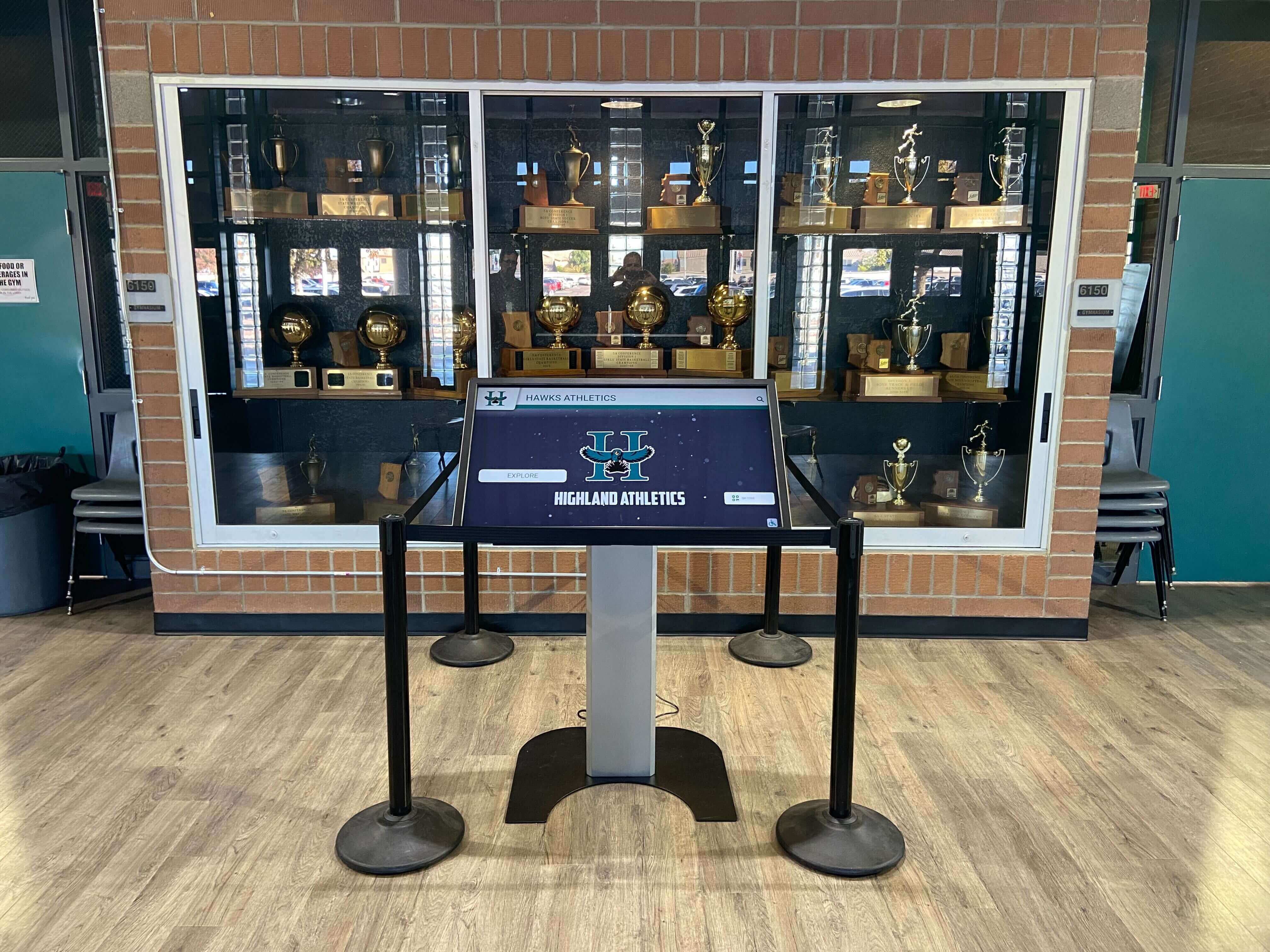Fall sports championships represent the pinnacle of autumn athletic competition, bringing together months of preparation, dedication, and teamwork into defining moments that shape program legacies and school communities. From Friday night lights illuminating championship football games to volleyball teams celebrating state titles to cross country runners crossing finish lines in championship races, fall sports create unforgettable experiences that deserve comprehensive recognition and celebration.
Yet many high schools struggle to properly honor fall sports championships in ways that preserve these achievements, inspire future athletes, and build the championship culture necessary for sustained excellence. Traditional recognition approaches often prove inadequate—championship banners fade in storage, trophy cases overflow with no room for new achievements, and the stories behind championship seasons get lost to time as participants graduate and move on.
This comprehensive guide explores proven strategies for recognizing, celebrating, and preserving fall sports championships through modern approaches that honor athletic excellence while building sustainable championship culture. Whether your school recently won its first fall sports title or boasts decades of autumn athletic success, understanding how to effectively showcase championship achievements creates lasting impact extending far beyond final whistles and championship ceremonies.
Understanding the Fall Sports Championship Landscape
Before examining specific recognition and celebration strategies, it’s essential to understand the unique characteristics of fall sports championships and why they deserve focused attention from athletic departments and school administrators.
The Diversity of Fall Sports Championships
Fall athletic seasons encompass remarkably diverse sports, each with distinct championship structures, competition formats, and recognition considerations that schools must navigate effectively.
Major Fall Sports Programs:
Football: The most visible fall sport in many communities, football championships often occur at multiple levels including conference titles, district championships, regional competitions, and state finals. The sport’s high profile creates intense community engagement making championship recognition particularly impactful for school pride and community identity.
Volleyball: Both girls and boys volleyball programs compete for fall championships in many states, with tournaments progressing through pools, brackets, and elimination formats. The indoor team sport creates strong team bonds and championship memories deserving comprehensive recognition.
Soccer: Boys and girls soccer programs pursue fall championships through regular season competition followed by playoff brackets. The sport’s global appeal and growing participation make soccer championships increasingly significant for school athletic programs.
Cross Country: Championship running combines individual achievement with team scoring, creating unique recognition opportunities. State meet performances, course records, and team championships represent different excellence forms deserving celebration.
Additional Fall Sports: Depending on state athletic associations and school offerings, fall championships may also include field hockey, golf, tennis, swimming and diving, gymnastics, competitive cheer, and other programs. Comprehensive recognition addresses all fall sports equitably regardless of program size or community profile.
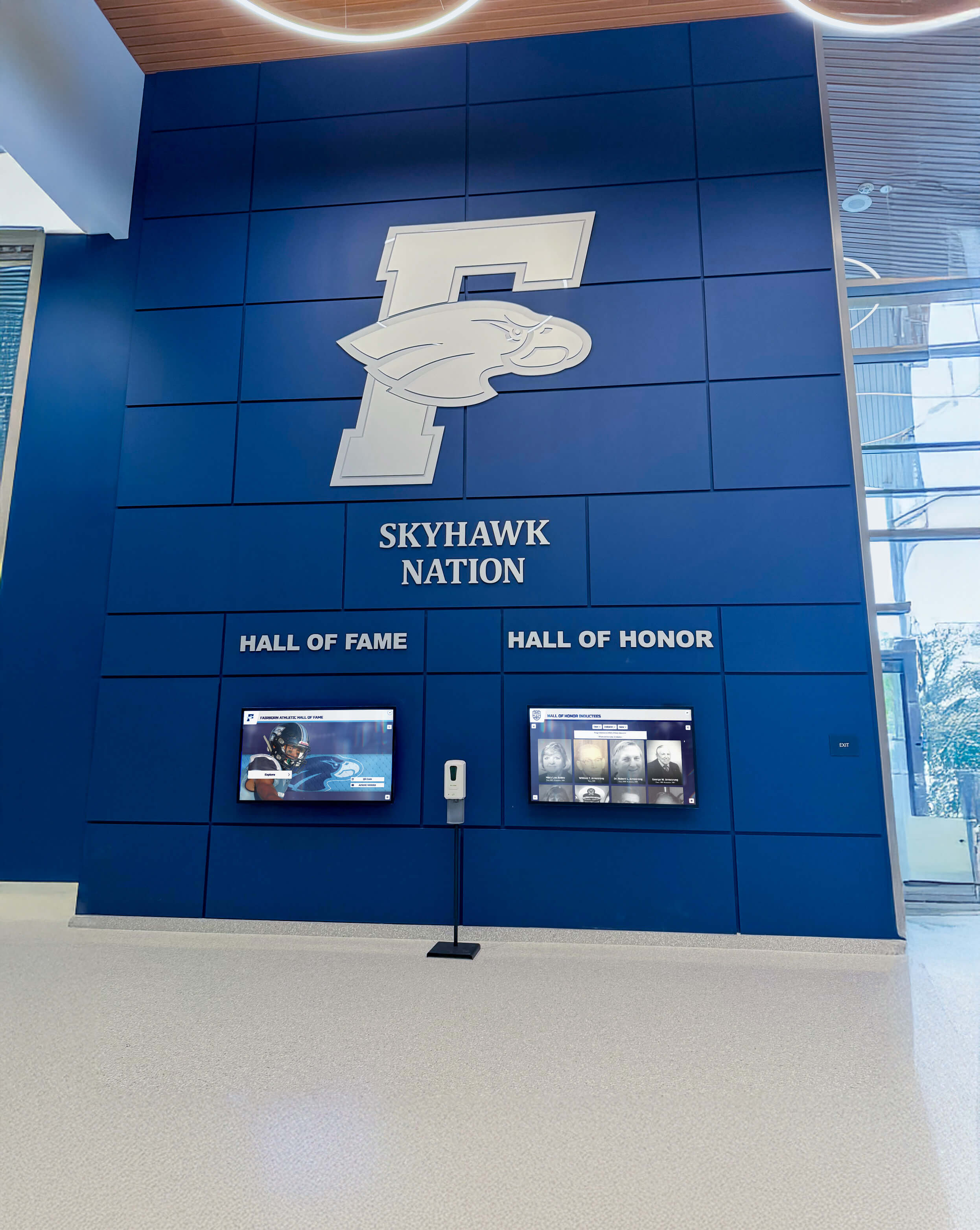
Championship Formats and Classification Systems
Understanding how fall sports championships are structured helps schools provide appropriate context when recognizing achievements.
Common Championship Structures:
Conference Championships: Regular season excellence within athletic conferences or leagues, typically determined by overall record or points accumulated. Conference titles represent sustained excellence over complete seasons.
State Association Tournaments: Most states organize championship tournaments through athletic associations, with classifications based on school enrollment. Understanding classification systems (1A through 6A, Division I through VII, or similar structures) ensures recognition provides proper achievement context.
Regional and District Competitions: Many championship paths include regional qualifying tournaments or district competitions that determine state tournament participants. These intermediate championships deserve recognition as significant program accomplishments.
National Recognition: Some fall sports offer national ranking systems or national championship opportunities through organizations monitoring high school athletics. National recognition represents the highest achievement level available to programs.
For schools exploring comprehensive athletic recognition programs that celebrate achievements at all levels, modern digital platforms enable flexible recognition frameworks accommodating diverse championship formats.
Why Fall Sports Championships Deserve Special Recognition
Fall sports championships carry unique significance warranting focused recognition and celebration distinct from winter and spring athletic achievements.
Special Characteristics of Fall Championships:
Season-Opening Momentum: Fall sports launch academic years with energy and excitement. Championship success during opening seasons establishes positive momentum influencing school culture throughout entire years. This timing amplifies fall championship impact on overall school spirit.
Community Gathering Traditions: Fall sports—particularly football—create community gathering traditions around Friday night games, playoff excitement, and championship pursuits. These traditions strengthen community bonds while making fall championships highly visible public celebrations.
Alumni Engagement Opportunities: Fall sports coincide with homecoming celebrations, providing natural opportunities to connect current championship teams with alumni who competed in previous eras. This intergenerational connection strengthens program traditions while engaging alumni.
Recruitment Critical Period: Many athletic recruiting processes intensify during fall months when college coaches evaluate prospects. Visible fall championship recognition during this critical period enhances program reputation and recruitment positioning.
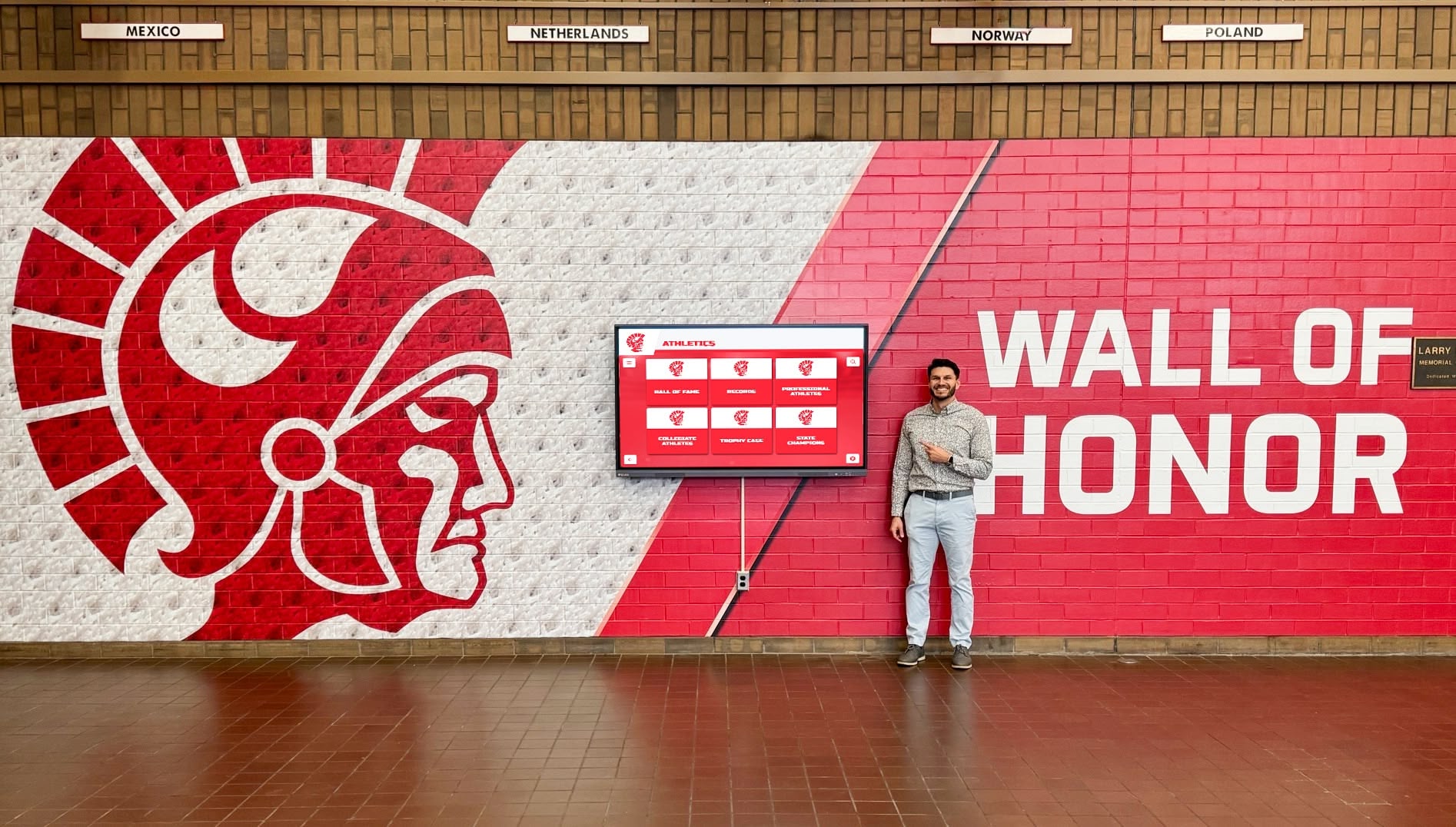
Comprehensive Recognition Strategies for Fall Sports Championships
Effectively honoring fall sports championships requires multifaceted approaches addressing immediate celebration, permanent recognition, and ongoing engagement that keeps championship achievements visible and meaningful long after seasons conclude.
Immediate Championship Celebration
When teams clinch fall sports championships, immediate celebration creates emotional high points that athletes and communities remember for lifetimes.
Championship Celebration Components:
Victory Acknowledgment at Events: Recognize championships during subsequent school events including assemblies, pep rallies, athletic competitions, and community gatherings. Public acknowledgment demonstrates institutional pride while allowing broader school communities to celebrate athletic excellence.
Championship Ceremony Planning: Organize formal championship recognition ceremonies featuring trophy presentations, roster acknowledgments, coach speeches, highlight video screenings, and community participation. Ceremonial elements add significance to championship achievements while creating memorable experiences for participants and supporters.
Social Media Championship Announcements: Immediately share championship news through school social media channels with photos, videos, statistics, and congratulatory messages. Digital announcements extend championship celebration beyond those physically present while generating community engagement and pride.
Local Media Coordination: Work with local newspapers, radio stations, and television outlets to ensure championship achievements receive appropriate media coverage. Media recognition validates excellence while informing broader communities about program success.
Championship Merchandise: Create championship-specific apparel and merchandise that athletes, students, and community members can purchase to commemorate title victories. Championship gear creates tangible memory items while generating program revenue.
Permanent Championship Documentation
Beyond immediate celebration, permanent recognition ensures fall sports championships remain visible and honored for decades after seasons conclude.
Permanent Recognition Approaches:
Digital Recognition Displays: Modern digital trophy case solutions provide dynamic platforms for showcasing fall sports championships with unlimited capacity, multimedia content, and engaging presentation formats that traditional physical displays cannot match.
Championship Banners and Signage: Traditional championship banners in gymnasiums, stadiums, and school buildings provide immediate visual recognition of program excellence. Ensure banner programs include all fall sports equitably rather than favoring high-profile programs.
Championship Trophy Cases: Physical trophy displays in school lobbies and athletic facilities create tangible connections to championship hardware. Organized trophy cases with proper lighting, labels, and context information transform collections into meaningful recognition displays.
Championship Wall Recognition: Dedicated wall spaces featuring championship plaques, photos, and narrative descriptions create permanent documentation accessible to students, visitors, and community members. Athletic hallways and facility entrance areas provide high-visibility locations for wall recognition.
Online Championship Archives: Web-based championship records accessible through school athletic websites ensure championships remain documented and searchable regardless of geographic location. Online archives prove particularly valuable for alumni seeking to reconnect with their championship experiences.
Solutions like Rocket Alumni Solutions provide comprehensive platforms specifically designed for educational athletic recognition, combining intuitive content management with professional presentation quality that properly honors fall sports championship excellence.
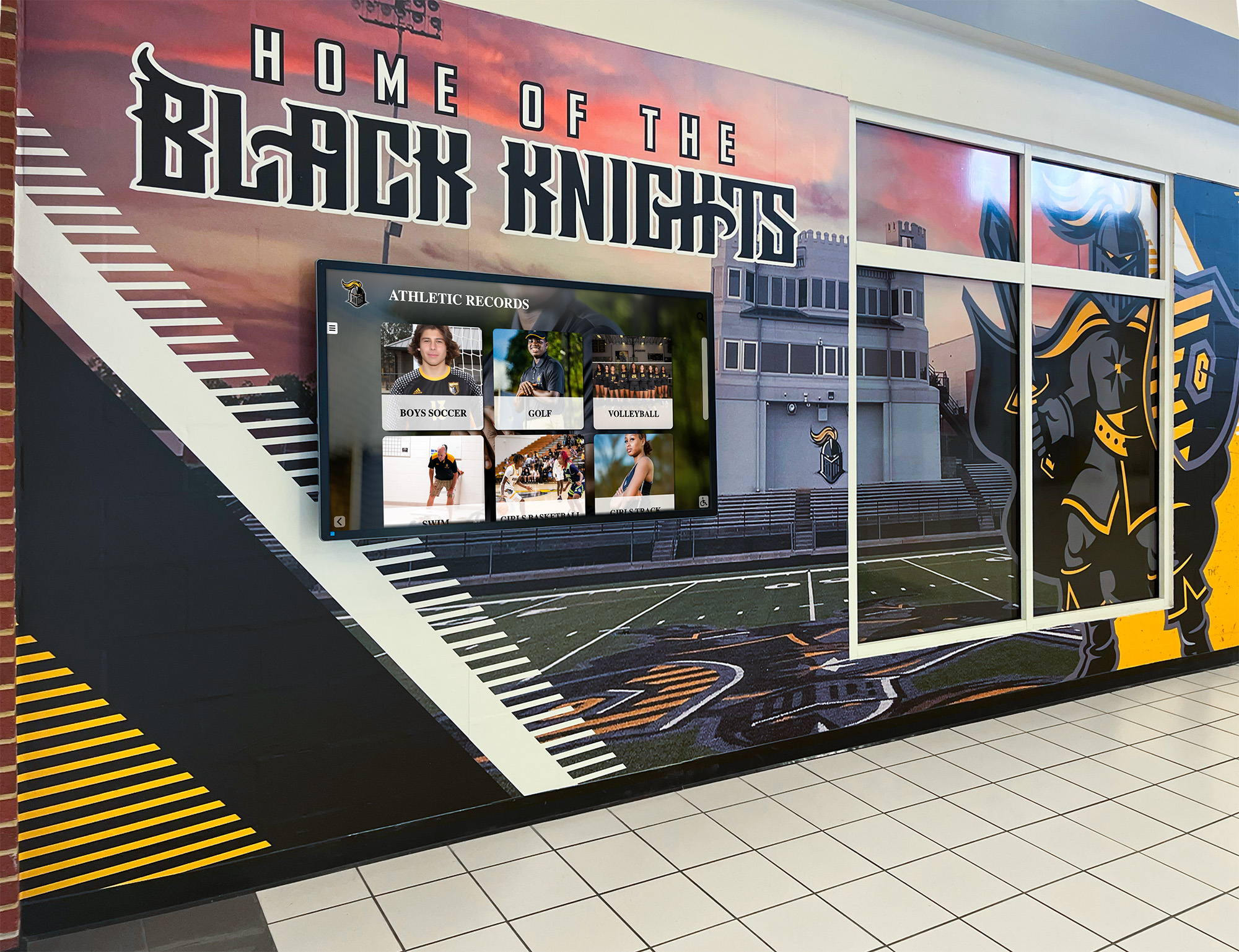
Multi-Layered Championship Content
The most effective fall sports championship recognition includes multiple content layers telling complete stories rather than simply documenting that teams won titles.
Championship Content Layers:
Essential Championship Information: Document fundamental championship details including sport and competition level, championship date and location, final score or results, season record, roster with all team members, coaching staff, and team captains or statistical leaders.
Championship Journey Narratives: Describe the path to championships including season progression, key victories, obstacles overcome, defining moments, and what made these particular championship teams special. Narrative content transforms championship listings into compelling stories.
Visual Documentation: Incorporate championship photos including team portraits, action shots from championship competitions, trophy and medal photos, celebration moments, and ceremony documentation. Visual content creates emotional connections that text alone cannot achieve.
Video and Multimedia Elements: When possible, include video highlights from championship competitions, coach and athlete interviews, season recap videos, and championship celebration footage. Multimedia content brings championships to life for viewers who didn’t experience them firsthand.
Individual Achievement Recognition: Within team championship context, acknowledge individual excellence such as all-state selections, individual championship performances, statistical leaders, and special recognition earned by team members. Balancing team and individual recognition ensures comprehensive acknowledgment.
Statistical and Record Documentation: Record championship season statistics, program records set during championship campaigns, historical championship comparisons, and statistical achievements placing seasons in program context.
For guidance on creating engaging digital recognition content that resonates with diverse audiences, explore proven storytelling approaches that transform achievements into inspiring narratives.
Building Championship Culture in Fall Sports Programs
Beyond recognizing championships after they occur, successful programs intentionally cultivate championship culture that makes excellence the expected standard rather than occasional surprise.
Visible Championship History and Tradition
Making championship history visible throughout athletic facilities creates constant reminders that excellence represents institutional tradition rather than isolated accomplishment.
Visibility Strategies:
Strategic Display Placement: Position championship recognition in high-traffic areas where current athletes encounter displays daily. Locker room areas, practice facility entrances, training rooms, and athletic offices provide consistent exposure creating psychological impact.
Locker Room Motivation: Install championship-focused displays in locker rooms where teams prepare mentally before competitions. Seeing championship predecessors documented nearby creates tangible connections between current athletes and program traditions.
Competition Venue Recognition: Ensure championship recognition is prominently displayed in competition venues where games occur. Championship banners, historical displays, and record boards visible to athletes during competitions reinforce championship expectations.
Academic Building Presence: Extend fall sports championship recognition beyond athletic facilities into main academic buildings. Broader placement demonstrates that athletic excellence matters to entire school communities while exposing non-athletes to program accomplishments.
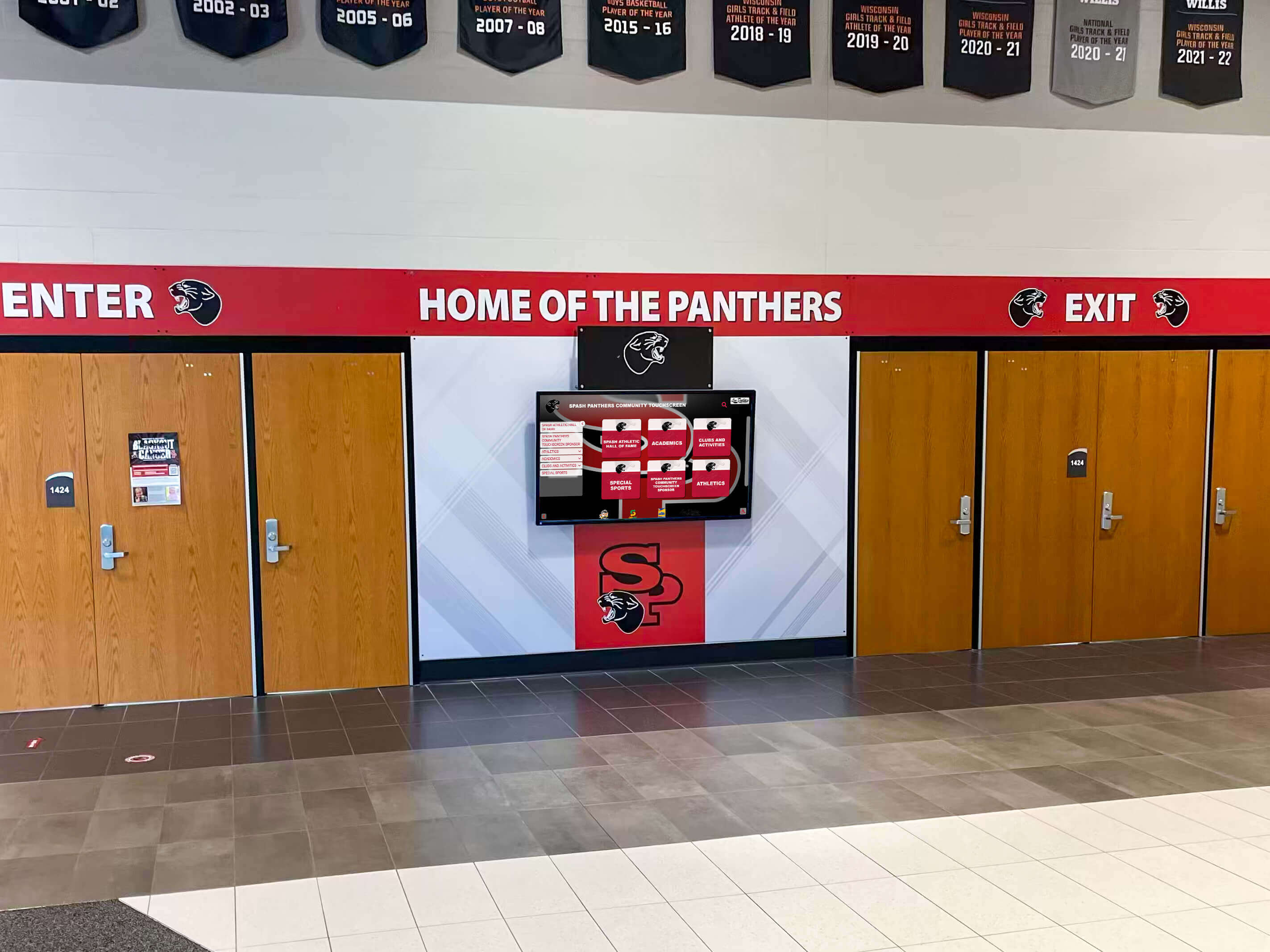
Championship Standards and Expectations
Establishing clear championship standards communicates expectations while providing specific targets that athletes work toward throughout their high school careers.
Standard-Setting Approaches:
Performance Benchmarks: Define specific performance standards associated with championship pursuit in each fall sport. Benchmarks might include qualifying times, scoring averages, defensive statistics, or other measurable indicators of championship-caliber performance.
Process Excellence Standards: Beyond outcome measures, establish process standards that produce championships such as practice attendance expectations, offseason training requirements, academic performance standards, and character behavior expectations. Process standards acknowledge that championships result from sustained excellence in daily actions.
Program Values Documentation: Clearly articulate program values underlying championship culture such as commitment, accountability, teamwork, discipline, and continuous improvement. Value documentation helps athletes understand that championships emerge from cultural foundations rather than talent alone.
Championship Team Examples: Use past championship teams as specific examples illustrating standards and values in action. Stories about how previous championship teams embodied program values make abstract standards concrete and achievable.
Alumni and Tradition Connection
Connecting current athletes with championship alumni creates intergenerational bonds while reinforcing that they’re part of ongoing traditions rather than isolated teams.
Alumni Connection Strategies:
Alumni Championship Profiles: Feature detailed profiles of championship alumni including their high school achievements, current accomplishments, and reflections on how championship experiences shaped their lives. Alumni profiles demonstrate lasting championship impact while providing aspirational examples.
Alumni Return Events: Organize events bringing championship alumni back to campus during fall sports seasons. Alumni participation in practices, attendance at key games, or speaking at team meetings creates direct connections between past and present championship teams.
Alumni Mentorship Programs: Facilitate mentoring relationships connecting current fall sport athletes with championship alumni. Structured mentorship provides guidance while strengthening program traditions across generations.
Championship Anniversary Celebrations: Mark significant championship anniversaries (10, 25, 50 years) with reunion events, recognition ceremonies, and updated displays. Anniversary celebrations honor past achievements while engaging alumni who maintain emotional connections to their championship experiences.
Understanding effective alumni engagement strategies helps schools create lasting connections that strengthen program culture while building support for current athletics.
Sport-Specific Championship Recognition Considerations
While many recognition principles apply across all fall sports, individual sports have unique characteristics requiring tailored recognition approaches.
Football Championship Recognition
Football’s prominence in many communities and its complex team structure require comprehensive recognition strategies addressing multiple achievement dimensions.
Football-Specific Recognition:
Positional Excellence Recognition: Document outstanding performances across offensive, defensive, and special teams units. Position-specific recognition ensures all contributors receive appropriate acknowledgment rather than focusing exclusively on skill position players.
Statistical Leaders and Records: Preserve championship season statistics for passing, rushing, receiving, tackles, sacks, interceptions, and other key metrics. Statistical documentation provides objective evidence of championship excellence.
Playoff Journey Documentation: Chronicle complete playoff paths from opening rounds through championship victories. Game-by-game results, scores, key plays, and championship bracket advancement create comprehensive championship narratives.
Coach and Staff Recognition: Acknowledge head coaches, assistant coaches, strength staff, athletic trainers, and support personnel whose contributions enabled championship success. Comprehensive recognition demonstrates that championships require contributions from entire programs.
Exploring football season recognition strategies provides additional guidance for honoring program excellence comprehensively.
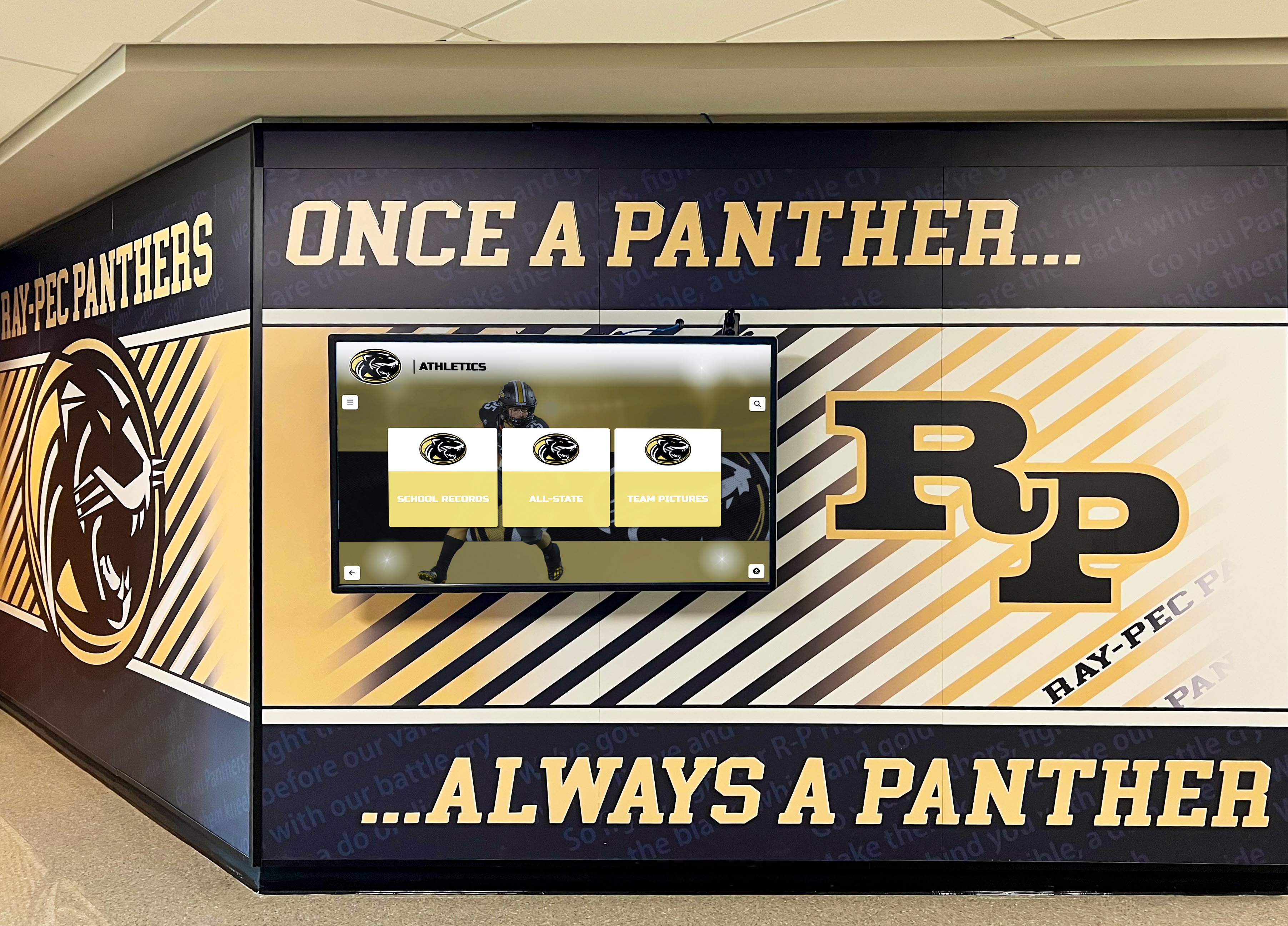
Volleyball Championship Recognition
Volleyball championships deserve equal recognition prominence despite receiving less community attention than football in many areas.
Volleyball-Specific Recognition:
Tournament Performance Documentation: Volleyball championships typically culminate in multi-day tournament formats. Document complete tournament results including pool play, bracket progression, semifinal and final matches with scores, sets won, and key statistical performances.
Statistical Excellence: Recognize statistical leaders in kills, blocks, digs, assists, serving, and hitting efficiency. Volleyball statistics provide objective measures of individual excellence within team contexts.
Team Chemistry Celebration: Volleyball’s unique rotation system and constant communication demands make team chemistry particularly important. Recognition acknowledging team unity, communication excellence, and collective effort honors what makes volleyball championship teams successful.
Gender Equity Emphasis: Ensure girls volleyball championships receive recognition quality and prominence equal to boys programs or other fall sports. Equitable treatment demonstrates institutional commitment to Title IX principles and fair recognition practices.
Soccer Championship Recognition
Soccer’s growing participation and global appeal make championship recognition increasingly important for program development and community engagement.
Soccer-Specific Recognition:
Offensive and Defensive Balance: Recognize both offensive excellence (goals, assists, shots) and defensive achievement (shutouts, saves, goals against average). Balanced recognition demonstrates appreciation for complete team performance necessary for championships.
Tournament Format Documentation: Document playoff bracket progression, opponent quality, and championship match details. Context about competition faced helps viewers understand championship significance.
International Player Recognition: Many soccer programs include international students or players with diverse cultural backgrounds. Recognition honoring diverse roster compositions demonstrates inclusive program culture while celebrating what international players contribute.
Club and High School Integration: Acknowledge relationships between high school championships and year-round club soccer development many players participate in. This recognition demonstrates understanding of contemporary soccer player development while honoring high school championship achievements specifically.
Cross Country Championship Recognition
Cross country’s individual and team scoring combination creates unique recognition opportunities requiring thoughtful approaches.
Cross Country-Specific Recognition:
Individual and Team Balance: Championships involve both team scoring and individual placement. Recognition should celebrate team championships while acknowledging individual excellence including race winners, all-state selections, and personal record performances.
Course Record Documentation: Preserve championship course times and conditions, allowing comparison across years while acknowledging that course difficulty variations affect direct time comparisons. Context helps viewers appreciate performance achievements properly.
Training Group Recognition: Cross country success often reflects training group cohesion and mutual encouragement. Recognition acknowledging team culture, training commitment, and supportive relationships honors what distinguishes championship programs beyond individual talent.
Improvement Narratives: Many championship cross country athletes show dramatic improvement over high school careers. Documentation of athlete development from freshman through senior years creates inspiring stories demonstrating that dedication produces results.
Understanding cross country record keeping and recognition approaches helps programs document distance running excellence comprehensively.
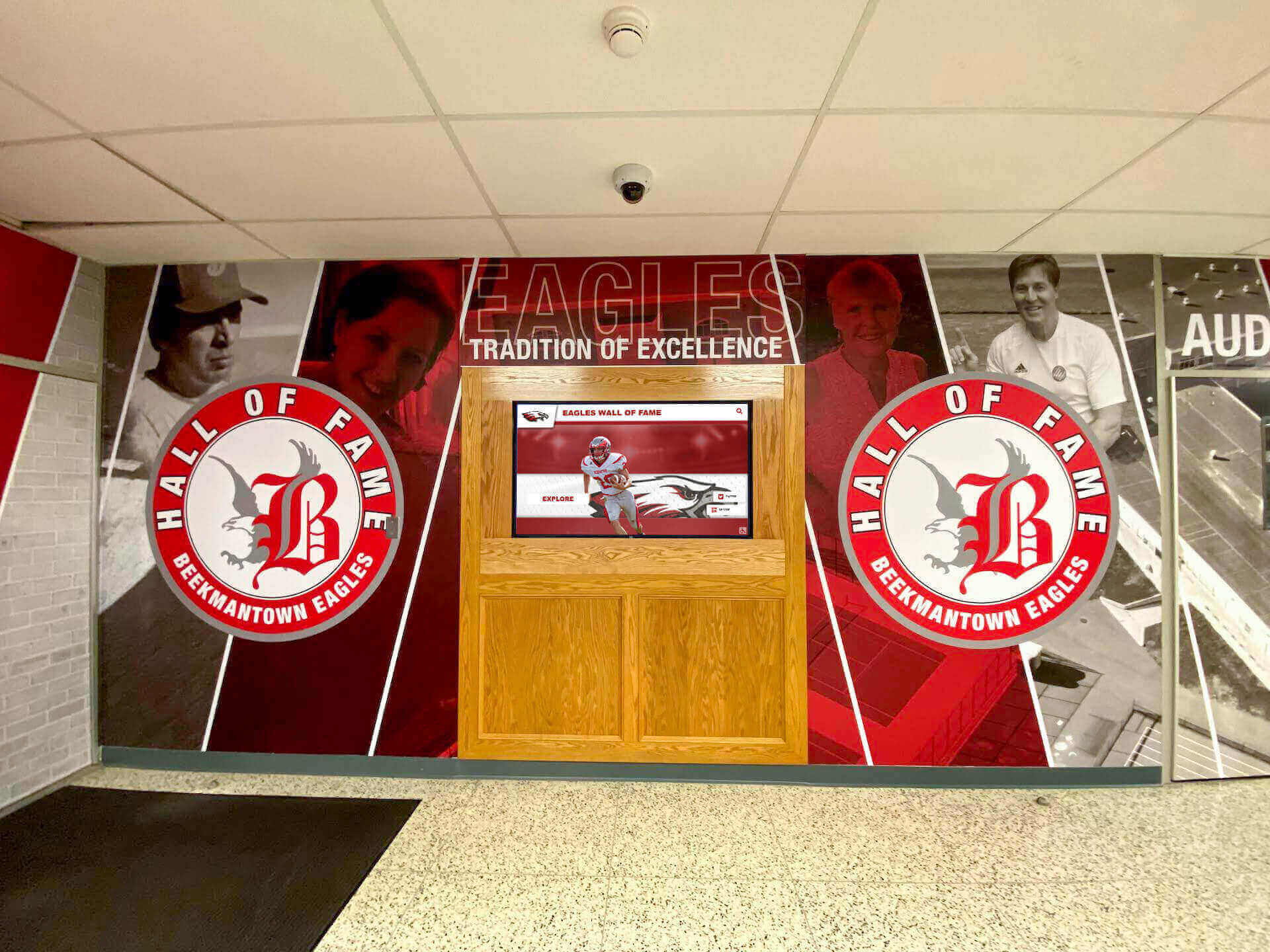
Modern Technology for Fall Sports Championship Recognition
Digital recognition technology transforms how schools honor fall sports championships by eliminating traditional limitations while introducing capabilities that enhance engagement and accessibility.
Interactive Digital Recognition Displays
Digital platforms provide dynamic alternatives to static physical recognition with advantages that make comprehensive championship celebration practical regardless of program size or championship quantity.
Digital Display Advantages:
Unlimited Recognition Capacity: Digital systems accommodate unlimited championship teams across all fall sports and decades without physical space constraints. Schools never face difficult decisions about which championships deserve display space—every fall sports championship receives comprehensive recognition.
Multimedia Storytelling Capabilities: Incorporate photos, videos, statistics, narratives, and interactive elements creating engaging experiences impossible with traditional trophy cases or wall plaques. Multimedia content brings fall championships to life while holding viewer attention longer than static displays.
Real-Time Content Updates: Add new championship recognition immediately after title victories without construction, installation delays, or material ordering. Update capability ensures recognition remains current while community excitement about championships remains high.
Search and Filter Functions: Allow visitors to search championships by sport, year, athlete name, coach, or keyword. Filtering enables personalized exploration letting individuals quickly find specific championships or athletes they’re interested in learning about.
Mobile and Web Access: Extend championship recognition beyond physical displays through mobile apps and web platforms accessible globally. Digital access allows alumni anywhere to explore fall sports championships while enabling current families to share achievements with extended networks.
Analytics and Engagement Tracking: Monitor how visitors interact with championship content through analytics revealing most-viewed championships, average engagement time, popular searches, and usage patterns. Data insights guide content development while demonstrating recognition program value.
Exploring touchscreen recognition solutions helps schools understand modern platforms specifically designed for educational athletic programs.

Cloud-Based Content Management
Modern recognition systems feature cloud-based management platforms enabling athletic staff to update championship content easily from any location without technical expertise.
Content Management Benefits:
Intuitive User Interfaces: Content management systems designed for non-technical users enable athletic directors, coaches, or administrative staff to add championships, upload photos, incorporate videos, and modify content through simple web-based interfaces requiring no programming knowledge.
Remote Update Capability: Manage championship content from any internet-connected device including office computers, laptops, tablets, or smartphones. Remote management means staff can add championship recognition immediately after title victories without returning to campus or accessing physical display locations.
Multi-User Collaboration: Allow multiple staff members to contribute content with role-based permissions controlling who can publish, edit, or review materials. Collaborative capability distributes workload while maintaining quality control.
Version History and Backup: Automatic version tracking and backup systems prevent data loss while allowing rollback to previous content versions if needed. Protection features ensure championship documentation remains secure and recoverable.
Template-Based Consistency: Content templates ensure championship entries maintain consistent formatting, required fields, and professional presentation quality regardless of who creates content. Templates streamline content creation while maintaining standards.
Integration with Existing Systems
Effective recognition platforms integrate with existing school technologies, avoiding isolated systems that create administrative burden.
Integration Capabilities:
Athletic Management Software: Connect with athletic scheduling, statistics, and roster management systems to pull championship data automatically rather than requiring manual re-entry. Integration reduces administrative work while ensuring accuracy.
Student Information Systems: Link with student databases to verify participant information, maintain accurate graduation years, and access additional athlete details enriching championship recognition.
Social Media Platforms: Enable direct sharing to Facebook, Twitter, Instagram, and other social channels without downloading and re-uploading content. Social integration extends championship recognition reach while simplifying content distribution.
Website Content Management: Publish championship recognition simultaneously to digital displays and school athletic websites through single content updates. Unified management prevents information inconsistencies while reducing duplicate work.
Implementing Fall Sports Championship Recognition Programs
Schools ready to enhance fall sports championship recognition should follow systematic implementation approaches ensuring comprehensive coverage, sustainable operations, and maximum impact.
Conducting Championship Inventory and Research
Begin by thoroughly documenting all fall sports championships achieved throughout program history, identifying information gaps, and establishing content development priorities.
Inventory Process Steps:
Championship Documentation: Research school archives, athletic department records, yearbooks, trophy cases, banner inventories, and historical media coverage to identify all fall sports championships across program history. Create master databases documenting championship year, sport, competition level, key participants, and available supporting materials.
Information Gap Analysis: Determine where championship documentation is incomplete or missing. Prioritize recent championships where information should be readily available while accepting that some historical championship details may be irretrievable.
Alumni Information Requests: Contact championship team alumni requesting photos, statistics, stories, memorabilia, and other materials they may have preserved. Many participants maintain personal archives significantly enriching official school records.
Media Archive Research: Search local newspaper archives, yearbook collections, and community historical societies for championship coverage providing additional context, statistics, and photographs.
Physical Material Digitization: Scan existing championship photos, newspaper clippings, programs, certificates, and documents to create digital versions. Professional digitization services ensure historical materials are preserved while maintaining archival quality standards.
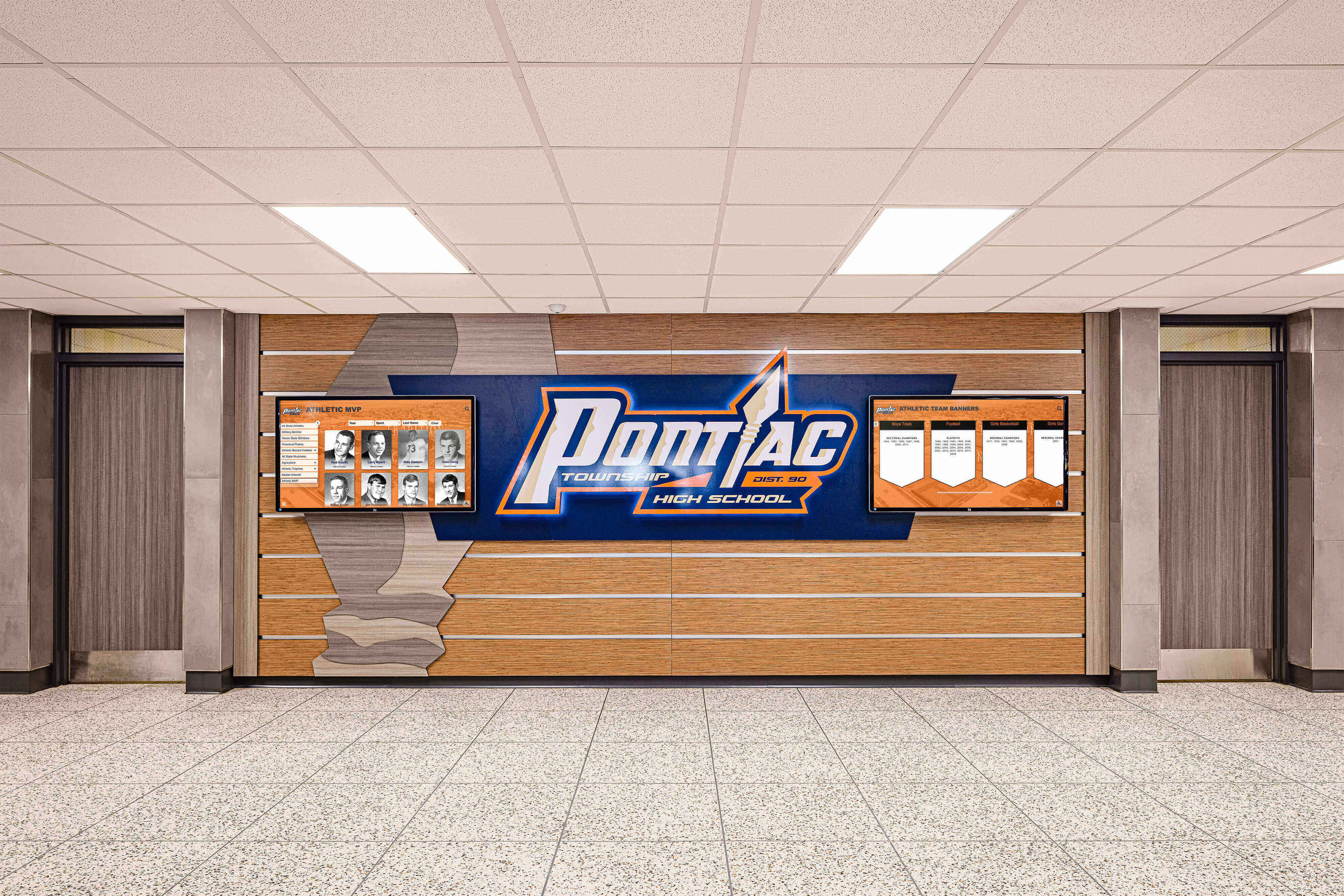
Establishing Recognition Standards and Guidelines
Create consistent content standards ensuring all fall sports championships receive professional, equitable recognition regardless of sport, era, or information availability.
Standard Development Areas:
Content Requirements: Define minimum information required for championship entries including essential data fields (sport, year, championship type, roster, coaches, record) and enhanced optional content (statistics, narratives, multimedia). Clear requirements ensure consistency while acknowledging information availability variations across championships from different eras.
Visual Quality Standards: Establish photo and video quality minimums including resolution specifications, composition guidelines, and formatting requirements. Quality standards ensure professional presentation while preventing substandard content from diminishing overall recognition program credibility.
Naming and Terminology Consistency: Create standardized terminology for championship types, competition levels, positions, awards, and other descriptive elements. Consistent language prevents confusion while enabling effective search and filtering functionality.
Equity Protocols: Document commitments to equitable recognition across all fall sports regardless of program profile, community visibility, or historical championship frequency. Equity protocols ensure smaller programs receive recognition quality matching high-profile sports.
Update Procedures: Establish workflows for adding new championships, updating existing entries as new information becomes available, and maintaining accuracy through periodic content audits. Documented procedures ensure sustainable operations despite staff transitions.
Phased Implementation Timeline
Most schools implement championship recognition incrementally rather than attempting comprehensive historical coverage before launching visible recognition programs.
Recommended Implementation Phases:
Phase 1: Current Season Championships (Year 1) Launch with comprehensive recognition for any fall sports championships achieved during current season. Immediate implementation demonstrates commitment while creating momentum. Document current championships exhaustively establishing standards for future additions.
Phase 2: Recent Championship Era (Years 1-5) Expand to championships from past five years where information is readily available, participants remain connected to programs, and communities remember championship seasons. Recent era content provides sufficient depth for meaningful displays while keeping initial implementation manageable.
Phase 3: Significant Historical Championships (5-20 Years) Add historically important championships from past decades including state titles, undefeated seasons, and championships that established program traditions. Historical content provides context while honoring teams that built program foundations.
Phase 4: Complete Historical Documentation (Ongoing) Systematically work backward through program history documenting all verifiable fall sports championships. Complete coverage may require years of incremental effort particularly for established programs with extensive championship traditions.
Phase 5: Enhanced Content Development (Continuous) Return to existing championship entries adding multimedia enhancements, expanded narratives, alumni testimonials, and additional documentation as resources allow. Continuous enhancement keeps content fresh while improving recognition depth over time.
Phased approaches allow earlier launches demonstrating value while distributing content development workload over extended periods making large projects manageable within typical athletic department resource constraints.
Promotion and Community Engagement
Even excellent championship recognition requires ongoing promotion ensuring target audiences discover and engage with recognition programs.
Promotion Strategies:
Launch Announcements: Communicate championship recognition program launches through school announcements, parent communications, local media coverage, social media campaigns, and community presentations. Comprehensive launch promotion builds awareness while generating initial engagement.
Campus Tour Integration: Incorporate championship recognition into standard campus tours for prospective students and families. Tour integration ensures athletic recruits encounter impressive championship displays during campus evaluations.
Event-Based Features: Highlight specific championships during relevant events such as homecoming (featuring historical championships), senior nights (honoring graduating championship participants), or sport-specific banquets. Event-tied features create natural connection points between recognition and school activities.
Social Media Campaigns: Share championship content through school social channels on championship anniversaries, when adding new championships, or as regular “throwback” features. Consistent social promotion extends recognition reach while engaging alumni and community members.
Alumni Communication Integration: Feature championship recognition in alumni newsletters, reunion materials, and alumni association communications. Alumni-focused promotion encourages returning graduates to explore recognition displays while reinforcing alumni connections.
Understanding comprehensive school pride building strategies helps schools leverage championship recognition within broader culture-building initiatives.
Measuring Fall Sports Championship Recognition Impact
Athletic administrators must demonstrate recognition program value justifying continued investment while identifying improvement opportunities that enhance effectiveness.
Quantitative Performance Metrics
Track specific metrics connecting fall sports championship recognition to desired outcomes across multiple program dimensions.
Key Measurement Areas:
Athletic Participation Trends: Monitor year-over-year participation numbers across fall sports programs. Increasing participation rates suggest recognition effectively communicates program excellence while inspiring student involvement.
Recruitment Success Indicators: Track quality of incoming fall sport athletes measured through prior competitive achievements, skill assessments, and recruiting competitiveness. Improved recruit quality indicates recognition enhances program reputation during recruitment processes.
Alumni Engagement Metrics: Measure alumni participation in athletic events, response rates to athletic communications, contributions to fall sport fundraising, and social media engagement with championship content. Stronger engagement suggests recognition successfully maintains alumni connections.
Recognition System Usage: Monitor digital display interaction data including session numbers, average engagement duration, most-viewed championships, and search patterns. Usage analytics demonstrate recognition value while revealing what content resonates most with audiences.
Community Awareness Indicators: Track local media coverage frequency, social media reach and engagement, game attendance trends, and community perception surveys. Growing awareness suggests championship recognition effectively communicates program excellence beyond school boundaries.
Program Performance Outcomes: While many factors influence competitive success, monitor whether comprehensive championship recognition correlates with improved team performance, championship frequency, or competitive positioning. Performance trends provide indirect recognition impact indicators.

Qualitative Feedback Collection
Numbers provide important measures, but qualitative feedback offers deeper understanding of how championship recognition influences stakeholder experiences and perceptions.
Feedback Collection Methods:
Current Athlete Surveys: Gather athlete perspectives about whether championship recognition influences motivation, pride, program choice decisions, or performance aspirations. Direct athlete feedback reveals recognition’s motivational impact.
Recruit and Family Interviews: During campus visits, collect informal feedback from prospects and families about championship display impressions and influence on program evaluations. Recruitment feedback demonstrates recognition’s competitive positioning value.
Championship Participant Testimonials: Request reflections from championship team members about recognition quality, accuracy, and whether displays honor achievements appropriately. Participant feedback ensures recognition authentically represents championship experiences.
Coach and Staff Input: Solicit coach perspectives about recognition program utility, ease of content management, and observed behavioral impacts. Staff insights reveal operational effectiveness while identifying improvement opportunities.
Alumni Focus Groups: Organize discussion sessions with championship alumni exploring recognition impact on institutional connections and suggestions for enhancement. Alumni feedback guides program evolution while strengthening relationships.
Community Stakeholder Interviews: Collect perspectives from boosters, school board members, administrators, and community leaders about recognition program value and community impact. Stakeholder feedback demonstrates broader institutional benefits.
Conclusion: Building Legacy Through Fall Sports Championship Recognition
Fall sports championships represent defining moments in athletic programs and school communities—culminating months of dedication, sacrifice, and teamwork into achievements that deserve comprehensive recognition matching their significance. Yet traditional recognition approaches increasingly fall short, limited by physical space constraints, static presentation formats, and inability to tell complete championship stories that capture the journey from season preparation through ultimate victory.
Modern digital recognition technology transforms fall sports championship celebration by providing unlimited capacity, multimedia storytelling capabilities, interactive engagement features, and simplified management making comprehensive recognition practical regardless of program size or championship history depth. Schools implementing systematic championship recognition programs honor past excellence while inspiring current athletes, strengthening recruitment, building championship culture, and creating lasting institutional assets.
The most successful fall sports championship recognition programs demonstrate several key characteristics that distinguish them from minimal recognition approaches: comprehensive coverage across all fall sports ensuring equity, consistent quality standards maintaining professionalism, authentic storytelling capturing what made championships special, accessible design serving diverse audiences, sustainable management procedures maintaining currency despite staff transitions, and strategic integration within broader athletic program development and school pride initiatives.
Schools that invest strategically in fall sports championship recognition reap substantial benefits extending far beyond simple acknowledgment. Comprehensive recognition creates motivational environments where excellence is expected, recruitment advantages differentiating programs from competitors, community engagement strengthening institutional support, alumni connections generating ongoing involvement, and most importantly, championship culture where sustained excellence becomes institutional identity rather than occasional occurrence.
Fall sports athletes who achieve championship success deserve recognition that doesn’t fade when banners deteriorate, disappear when trophy cases overflow, or get forgotten when participants graduate and new seasons begin. They deserve recognition that inspires for generations, preserves legacies permanently, and honors the remarkable dedication required to achieve championship excellence in competitive high school athletics.
Ready to transform how your school recognizes fall sports championships? Solutions like Rocket Alumni Solutions provide comprehensive platforms specifically designed for educational athletic programs, combining intuitive technology with professional support and proven best practices. Every championship represents extraordinary achievement—modern recognition systems ensure these accomplishments receive the lasting honor they truly deserve.
